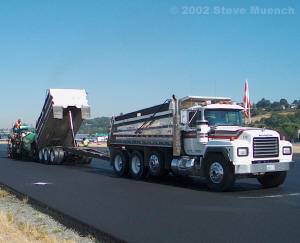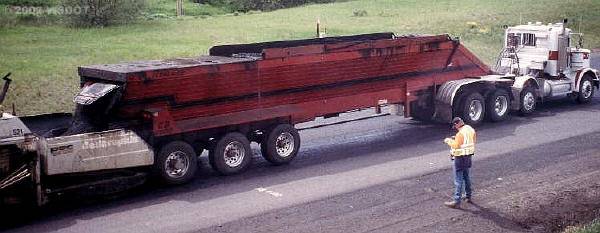Transport
Mix transport involves everything required to convey HMA from a production facility to a paving site including truck loading, weighing and ticketing, hauling to the paving site, dumping of the mix into the paver or material transfer vehicle hopper, and truck return to the HMA production facility (Roberts et al. 1996). Ideally, the goal of mix transport should be to maintain mix characteristics between the production facility and the paving site.
Truck Types
There are three basic truck types used for mix transport classified by their respective HMA discharge methods:
- End dump. End dump trucks unload their payload by raising the front end and letting the payload slide down the bottom of the bed and out the back through a tailgate (Figure 1). They are the most popular transport vehicle type because they are plentiful, maneuverable and versatile.
- Bottom dump (or belly dump). Bottom dump trucks (Figure 2) unload their payload by opening gates on the bottom of the bed. Internal bed walls are sloped to direct the entire payload out through the opened gates. Discharge rates can be controlled by the degree of gate opening and the discharge is usually placed in an elongated pile, called a windrow, in front of the paver by driving the truck forward during discharge. Windrows require a special MTV to feed the HMA into the paver.
- Live bottom (or flo-boy). Live bottom dump trucks (see Figure 3) have a conveyor system at the bottom of their bed to unload their payload. HMA is discharged out the back of the bed without raising the bed. Live bottom trucks are more expensive to use and maintain because of the conveyor system but they also can reduce segregation problems and can eliminate some detrimental types of truck bed – paver contact (because the bed is not raised during discharge).

Figure 1: End Dump Truck

Figure 2: Bottom Dump Truck

Figure 3: Live Bottom Truck
Transport Considerations
There are several mix transport considerations, or best practices, that are essential to maintaining HMA characteristics between the production facility and the paving site. These considerations can generally be placed into four categories:
- Loading at the Production Facility. Truck beds should be clean and lubricated with non-petroleum products to prevent the HMA from sticking to the truck bed. Petroleum based products, such as diesel fuel, should not be used because of environmental issues and because they tend to break down the asphalt binder. HMA should be discharged into the truck bed so as to minimize segregation. Dropping HMA from the storage silo or batcher (for batch plants) in one large mass creates a single pile of HMA in the truck bed. Large-sized aggregate may roll off this pile and collect around the base. Dropping HMA in several smaller masses (three is typical) at different points in the truck bed will help minimize the segregation risk.
- Truck transport. Truck transport affects HMA characteristics through cooling. HMA is usually loaded into a truck at a fairly uniform temperature between 250°F to 350°F. During transport, heat is transferred to the surrounding environment and HMA temperature drops. However, cool HMA provides excellent insulation and thus transported HMA tends to develop a cool thin crust on the surface that surrounds a much hotter core. Things such as air temperature, rain, wind and length of haul, insulated truck beds and truck tarps can affect the characteristics and temperature of this crust.
- Unloading at the paving site. HMA should be unloaded soon after it arrives at the paving site in order to minimize mix cooling. Also, on jobs with more than one mix type the inspector and/or foreman should be certain the correct mix is loaded into the paver.
- Operation synchronization. Truck transport should be planned such that the HMA transport rate (expressed in tons/hr) closely matches plant production rate and laydown rate. Traffic affects HMA delivery rates because it affects truck speed. Especially in congested urban areas, heavy and/or unpredictable traffic may substantially increase, or at least vary, truck travel time. As truck travel time increases, more trucks are needed to provide a given HMA delivery rate. Therefore, as traffic gets worse, trucking costs increase. Additionally, the unpredictability of traffic may result in either long paver idle times while waiting for the next truckload of HMA or large truck backups as several trucks all reach the paving site or production facility at the same time.
Construction



